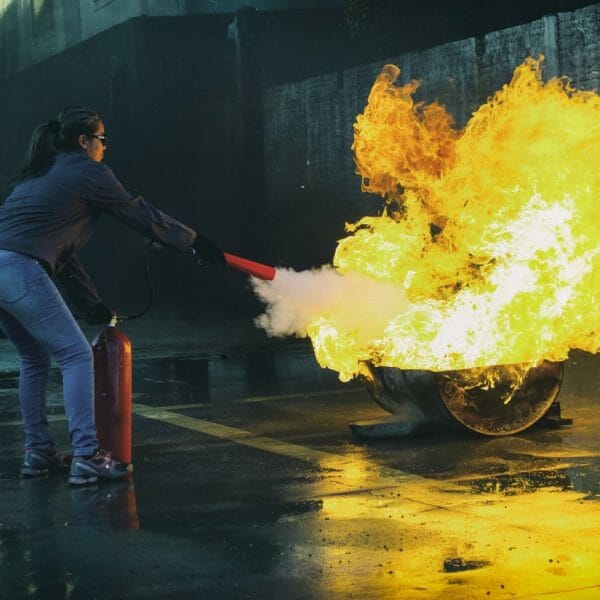
Fire extinguishers are a safety device that’s always there when you need it, and fortunately, you usually never need one. However, once in a while, there’s a fire. And you or somebody else showed the courage and initiative to use the available extinguisher to put it out. Now you have to deal with fire extinguisher cleanup.
Now, you’ve got a mess and an empty fire safety device, so what do you do? First, you need to clean up the debris resulting from the extinguisher’s discharge. Below is a description of the various types you may have, and how to clean each one. But if you have any doubts or concerns, don’t hesitate to contact the experts at All Protect Systems, Inc.
Types of Extinguisher Types and Cleanup
Different types of fires ignite in different environments, and an expert selected your extinguisher for that location. Each kind has different chemicals to put out various fire types, and they all require their own cleanup. The most common types of extinguisher include:
1. Dry Chemical Extinguisher
Using an array of effective fire fighting chemicals including sodium bicarbonate, monoammonium phosphate, and potassium bicarbonate, they’re rated for A, B, and C type fires.
Though excellent in disrupting a fire’s chemical reaction, it leaves behind a toxic powder, which you should clean as soon as possible. You can obtain the best results with the following steps:
- Vacuum up any loose debris
- Spray any caked-on residue with a mixture of rubbing alcohol and warm water. Wipe with a damp rag.
- A 25 to one ratio of hot water to vinegar can neutralize residue from potassium bicarbonate and sodium bicarbonate. Spray it on and wipe with a damp rag.
- A paste made from hot water and baking soda neutralizes monoammonium phosphate. Apply liberally and wipe clean with a damp rag.
- Clean all affected cooking utensils or dishware as you normally would.
2. Class K Wet Chemical Extinguishers
Designed for the requirements commercial kitchens, wet chemical extinguishers discharge a fine chemical low-PH mist that creates a barrier between a fire’s fuel and its oxygen. Before any more food preparation, clean any residue using the following steps:
- Cut power to any appliances.
- Wear rubber gloves when cleaning to avoid skin contact with the chemicals.
- Wipe the affected area down with a sponge or towel and hot soapy water.
3. Clean Agent Extinguishers
Explicitly designed for putting out electrical fires, clean agent extinguishers emit non-conductive halon and halocarbon agents. They disrupt the fire’s chemical reaction and remove heat. True to their name, their discharge dissipates into the air, and no cleanup is necessary.
4. ATC Foam Extinguisher
Best used for diesel and gasoline fires, ATC foams are also effective on wood and paper fires. Cleanup includes:
- Check the MSDS safety sheet for your extinguisher to learn if it contains toxic chemicals.
- Use personal protective gear for your hands and eyes if the foam is toxic.
- Don’t use water to clean the foam. It will only create more foam.
When to Call a Professional
Not every fire extinguisher cleanup should be considered a DIY job. There are situations when you should call professional cleaners, such as:
- The residue covers expensive items
- You can’t clean the mess immediately. Permanent damage may occur to your building’s furniture or carpets if you don’t promptly clean the residue.
- There’s a threat of the chemical agents entering local water supplies, or your plumbing or HVAC system may be contaminated.
Whatever type of extinguisher you’ve used, recharging or replacing your extinguisher should occur in tandem with your cleanup. Besides being required by the Ontario Fire Code, fire extinguishers are a vital tool in life safety and property protection.
All Protect Systems, Inc can check, inspect, test, refill, or replace any style of fire extinguisher you have. In fact, we can service all of your fire protection needs. Call us today!